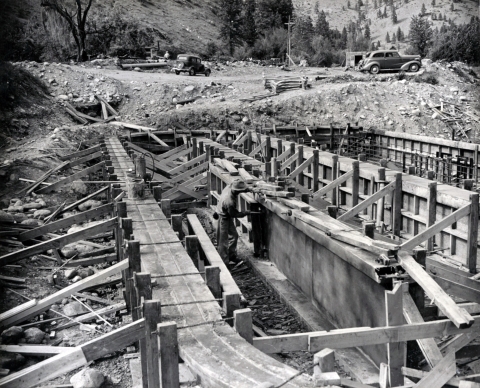About Us
Our hatchery runs an incredibly successful summer Chinook program that supports an annual fishery on the Columbia and Entiat rivers. Water at our site is used with care and innovation.
Our Mission
The goal of the program is to maintain a segregated harvest program for summer Chinook. Fish from this program are not intended to spawn naturally and are not intended to establish, supplement, or support any summer Chinook salmon populations occurring in the natural environment. Released smolts and returning adult fish must travel 490 river miles between the hatchery and the Pacific Ocean.
Our History
Entiat National Fish Hatchery (ENFH) was built on 37 acres of land by the Bureau of Reclamation as one of the fish mitigation facilities for Grand Coulee Dam, Columbia Basin Project.
Fish culture work began in 1941. At that time the hatchery consisted of a water intake structure structure
Something temporarily or permanently constructed, built, or placed; and constructed of natural or manufactured parts including, but not limited to, a building, shed, cabin, porch, bridge, walkway, stair steps, sign, landing, platform, dock, rack, fence, telecommunication device, antennae, fish cleaning table, satellite dish/mount, or well head.
Learn more about structure on the Entiat River, pipelines, a screen chamber, hatchery building, mixing chamber, domestic water system, four residences, and eight large and four small fish rearing ponds designed by engineers by the names of Foster and Lucas. The initial operating plan for the ENFH called for adult salmon and steelhead to be trapped at Rock Island Dam and hauled to the hatchery for holding and spawning. We served as a research facility in the early days to learn more about fish health.
The hatchery was substantially reconstructed in 1979, which included the replacement of the Foster-Lucas rearing ponds with thirty 8’ x 80’ raceways, adult holding ponds, fish ladder, screen chamber and mixing chamber, and a generator building. Following this upgrading of the facility, spring Chinook salmon was the primary species raised from 1979 to 2008.
Beginning in the fall of 2009, the ENFH began raising summer Chinook salmon. The program was initiated with eggs from Wells Fish Hatchery.
Other Facilities in this Complex
Entiat, Leavenworth, and Winthrop National Fish Hatcheries are mitigation hatcheries established by the Grand Coulee Fish Maintenance Project (1937) to compensate for anadromous fish losses above Grand Coulee Dam. All three produce spring or summer Chinook salmon, and Winthrop NFH produces steelhead.
As part of the Leavenworth Fisheries Complex, the Mid-Columbia Fish and Wildlife Conservation Office evaluates the hatchery production programs, provides technical assistance, and assists the coordination of operations and production. The MCFWCO cooperates with other Service programs, agencies, tribes, and entities using and managing aquatic species and their habitats in the mid- and upper-Columbia River Basin.



